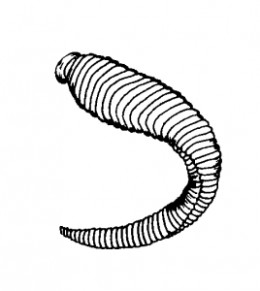
Hirudinaria granulosa
(Indian cattle leech)
|
The word 'leech' derived from the Anglo-Saxonic term loece, means 'to heal'. Physicians of the 5th-11th century England were known as 'leeches', the book of medicine was leechdom and the practice of medicine was leechcraft (see Anglo-Saxon leechcraft: an historical sketch of early English medicine, American Medical Association, 1912, Burroughs Wellcome & Co., New York).
Practitioners of complementary and alternative medicine use the live-leech therapy to manage pain. Besides traditional medical practices followed in Greece and Arabia, the Indian medical system also uses leeches in their medical management. Phlebotomy, i.e. draining blood from human body in a controlled manner, was a valid medical treatment tactic in the Europe of the 1800s. Several bloodletting techniques existed, but none was as efficient and painless as was the use of leeches. For treating any blood-coagulation disease, we today use Heparin (or heparinoids, the synthetic equivalents of heparin). Because natural heparin was isolated from canine liver cells, it derives its name as Heparin ('hepar' [Greek] = liver). Until heparin came into use in the early 20th Century, leech therapy was popular.
Leech is a freshwater animal, classed under the Annelida. At one end of its worm-like body is a large sucker by which it attaches itself to the ground, and at the other end it is a smaller sucker, in the middle of which is a chitinous mouth with which it inflicts a triangular puncture on the animal (or human) it would feed on. Leech saliva includes a natural anticoagulant (hirudin). When a leech is attached to mammalian skin, its action repairs damaged veins. Once normal vein flow is restored, the leech can be removed. Some surgeons, even today, occasionally use leeches in procedures, such as in the surgical treatment of periorbital haematoma and in diverse plastic surgeries. The cream marketed as Hirudoid™ is a synthetic product that mimics the anticoagulating principle of the leech (hence 'Hirud-oid'). Leech saliva inhibits platelet aggregation, which is induced by collagen, ADP, and epinephrine.
As items of Materia Medica, leeches were dispensed in dispensaries and sold by apothecaries (= pharmacies) in the 19th Century to physicians and patients. The species most commonly used for bleeding was Hirudo medicinalis, indigenous to the streams and swamps of Central and Northern Europe, and known in commerce as the Swedish or German leech. In the late 19th Century, Swedish leeches were sold in America for $5/100. The Hungarian leech (indigenous to Southern Europe) and the American leech, Hirudo decora, were also used in leach therapy.
Phlebotomy was so common in the 1800s that in 1833 alone France imported more than 42 million leeches. By the end of the 19th Century, Western Europe had exhausted its local stock of leeches (Hirudo medicinalis). Jean-Baptiste Sarlandière (1787–1838), a French human anatomist – physiologist devised a mechanical leech (bdellomètre) because of paucity of leeches in Western Europe. Therefore, leech harvesting became a paying activity at the time.
Warm shallow water stands in peninsular India had a 'plentiful' stock of leeches. People waded through leech-infested waters and collected them. Pharmacists in Mauritius – a French colony in the 18th and 19th Centuries imported leeches from Pondicherry. Random issues of the Mauritian newspaper Journal de l'Ile Maurice published between 1833 and 1872 included catchy advertisements placed by pharmacists in Mauritius offering medicinal leeches imported from Pondicherry at competitive prices.
Pondicherry was a major exporter of leeches in the 19th Century. Sadly, no further details are available about who dealt with the trade, and how and from where in Pondicherry the leeches were procured. Increasing numbers of people of Indian origin in Mauritius could be a factor for leech import from Pondicherry to Mauritius. With the abolition of slavery in 1835, many Indian labourers moved to Mauritius, who may have taken with them the practice (and the principles?) of Ayurveda, which extensively used leeches (Chapter 13, Suœruta Œamhita, 200 BC) as a treatment strategy.
Leeches were also, possibly, exported to West Indies from Pondicherry, at least 15 years before the British ships brought Indian emigrants. Which leech species were imported into Mauritius from Pondicherry is uncertain. In a high likelihood, it is the large, aggressive cattle leeches Hirudinaria manillensis, which occur abundantly throughout India. Hirudo granulosa (Indian cattle leech) was used by medical practitioners of 18th-19th Century Pondicherry.
|